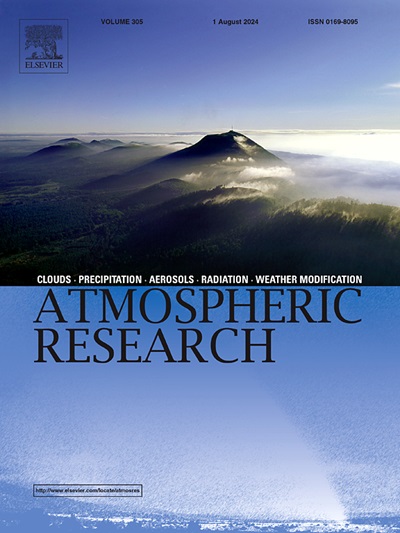Modulation of landfalling tropical cyclone activity in the western North Pacific by North Atlantic tripolar SST
IF 4.5
2区 地球科学
Q1 METEOROLOGY & ATMOSPHERIC SCIENCES
引用次数: 0
Abstract
Previous research on the effects of Atlantic sea surface temperature (SST) on tropical cyclones (TCs) in the western North Pacific (WNP) has primarily focused on the tropical Atlantic region. This study investigates the relationship between the extra-equatorial North Atlantic tripole (NAT) sea surface temperature anomaly (SSTA) pattern and landfalling TCs in the WNP. The findings reveal a significant positive lead-lag correlation between the negative–positive–negative NAT SSTA pattern and the genesis of landfalling TCs in the WNP. In high NAT years, more TCs form in the WNP and recurve northeastward to make landfall over the Korean Peninsula and Japan, while fewer TCs move westward or northwestward. The NAT tropical cold SSTA transmits signals to the WNP and modulates TC genesis via two ways: the eastward pathway through the North Indian Ocean and the westward pathway through the eastern North Pacific. This enhances cyclonic vorticity in the WNP monsoon trough region, facilitating increased TC genesis frequency in the region and thereby increasing the genesis frequency of landfalling TCs. Furthermore, the NAT SSTA influences the tracks of these landfalling TCs. The NAT SSTA pattern persists into summer, triggering a mid-high latitude teleconnection wave train that propagates downstream. This induces an anomalous anticyclone over Northeast Asia and an accompanying cyclonic circulation to its west. This circulation leads to the recurving of TC tracks rather than a northwestward or westward direction. The results suggest that the NAT SSTA is a potential predictor of TC formations and track patterns in the WNP.
北大西洋三极海温对北太平洋西部登陆热带气旋活动的调制
以往关于大西洋海温(SST)对北太平洋西部热带气旋(tc)影响的研究主要集中在热带大西洋地区。本文研究了赤道外北大西洋三极(NAT)海温异常(SSTA)模式与西西北地区登陆tc的关系。研究结果表明,负-正-负NAT - SSTA模式与WNP中登陆tc的成因之间存在显著的正相关关系。在高NAT年份,更多的tc在西西北地区形成,并向东北移动,在朝鲜半岛和日本登陆,而较少的tc向西或西北移动。NAT热带冷海温通过东经北印度洋和西经北太平洋两种途径向WNP发送信号并调节TC的形成。这增强了WNP季风槽区的气旋涡度,促进了该区域TC发生频率的增加,从而增加了登陆TC的发生频率。此外,NAT SSTA影响了这些登陆tc的路径。NAT - SSTA模式持续到夏季,引发中高纬度远相关波序列向下游传播。这在东北亚上空引发了一个异常反气旋,并在其西面产生了一个伴随的气旋环流。这一环流导致了TC路径的回流,而不是向西北或向西移动。结果表明,NAT SSTA是WNP中TC形成和路径模式的潜在预测因子。
本文章由计算机程序翻译,如有差异,请以英文原文为准。
求助全文
约1分钟内获得全文
求助全文
来源期刊

Atmospheric Research
地学-气象与大气科学
CiteScore
9.40
自引率
10.90%
发文量
460
审稿时长
47 days
期刊介绍:
The journal publishes scientific papers (research papers, review articles, letters and notes) dealing with the part of the atmosphere where meteorological events occur. Attention is given to all processes extending from the earth surface to the tropopause, but special emphasis continues to be devoted to the physics of clouds, mesoscale meteorology and air pollution, i.e. atmospheric aerosols; microphysical processes; cloud dynamics and thermodynamics; numerical simulation, climatology, climate change and weather modification.
 求助内容:
求助内容: 应助结果提醒方式:
应助结果提醒方式:


